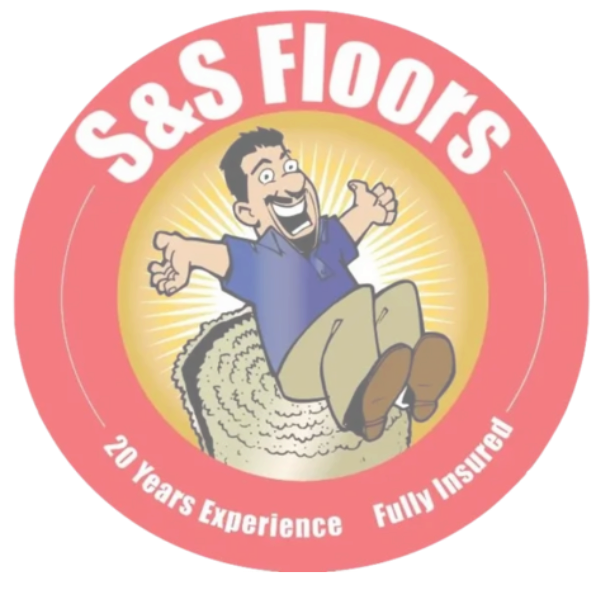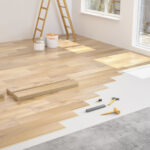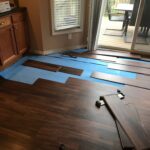Vinyl plank flooring has rapidly gained popularity among homeowners in O’Fallon, MO, and across the country. Known for its versatility and durability, vinyl plank flooring is an excellent choice for various living spaces. This blog delves into the advantages and disadvantages of vinyl plank flooring while offering crucial maintenance tips to keep your floors looking fantastic for years.
What is vinyl plank flooring?
Vinyl plank flooring offers a synthetic alternative that replicates the appearance of natural materials such as hardwood and stone. It consists of multiple layers, featuring a wear layer that guards against scratches and stains, a printed design layer for visual appeal, a sturdy core layer for stability, and a backing layer that provides comfort underfoot. Available in a wide range of colors and styles, vinyl plank flooring can suit any home aesthetic.
Pros of Vinyl Plank Flooring
- Affordability: One of the most significant advantages of vinyl plank flooring is its affordability. Compared to hardwood or tile, vinyl planks are typically less expensive to purchase and install. This makes it a smart choice for homeowners who want to enhance their floors affordably.
- Durability: Vinyl plank flooring can handle heavy foot traffic, making it a perfect option for bustling households. The wear layer safeguards against scratches, dents, and stains, helping your floors retain their appearance over the years. Additionally, vinyl planks are resistant to moisture, making them suitable for areas like kitchens and bathrooms.
- Ease of Installation: Installing vinyl plank flooring is straightforward, particularly with a click-lock design. Many homeowners in O’Fallon choose to install vinyl planks themselves, saving on labor costs. For optimal results, hire a professional for installation.
- Comfort and Sound Absorption: Unlike harder flooring options like tile, vinyl plank flooring provides a softer and more comfortable surface underfoot. Its cushioned feel is especially appealing in areas where you stand for long periods, such as the kitchen. Additionally, vinyl planks offer sound absorption, reducing noise levels in your home.
- Variety of Styles: With countless colors, patterns, and textures available, vinyl plank flooring can seamlessly fit into any interior design scheme. Whether you prefer the rustic look of reclaimed wood or the sleek appearance of modern tiles, there’s a vinyl plank option for you.
Cons of Vinyl Plank Flooring
- Limited Lifespan: While vinyl plank flooring is durable, it generally has a shorter lifespan compared to hardwood. High-quality vinyl can last between 10 and 20 years, while hardwood floors can last a lifetime with proper care. Homeowners should weigh this factor when considering long-term investments.
- Susceptibility to Fading:Vinyl plank flooring can fade over time, especially when exposed to direct sunlight. While some manufacturers offer UV-resistant options, it’s essential to consider window treatments and placement to protect your floors from fading.
- Repair Challenges: Repairing damaged vinyl plank flooring can be more challenging than fixing other materials. While you can often buff out minor scratches, replacing a damaged plank typically requires professional assistance to achieve a seamless finish.
- Environmental Concerns: As a synthetic material, vinyl is not biodegradable and may release harmful chemicals during manufacturing and disposal. If sustainability is a concern for you, consider researching eco-friendly flooring options or choosing products made with recycled materials.
Maintenance Tips for Vinyl Plank Flooring
- Regular Cleaning: Sweep or vacuum your vinyl floors regularly to remove dirt and debris. To achieve a thorough clean, use a damp mop and a gentle, pH-balanced cleaner specifically formulated for vinyl flooring. Steer clear of strong chemicals that may harm the surface.
- Prevent Scratches: Use furniture pads under the legs of chairs and tables to prevent scratches and dents. Be cautious when moving heavy furniture, and consider using a dolly or lifting equipment to avoid damaging your floors.
- Control Humidity: While vinyl plank flooring is moisture-resistant, it’s essential to control humidity levels in your home. Use dehumidifiers in damp areas to prevent excess moisture, which can lead to warping or buckling.
- Shield Your Floors from Sunlight: To minimize fading, consider using window treatments to block direct sunlight from hitting your floors. Installing area rugs in high-traffic areas can also protect your vinyl planks from wear and tear.
- Address spills promptl: Clean up spills as soon as they occur to prevent stains and damage. Use a soft cloth to blot the area, and avoid rubbing, which can spread the liquid further.
Read : 5 Signs Your Vinyl Plank Flooring Needs Repair (And What to Do About It)
Wrapping Up: Key Points to Remember About Vinyl Plank Flooring
Vinyl plank flooring offers numerous benefits, including affordability, durability, and a wide variety of styles. However, it’s essential to consider the potential drawbacks, such as limited lifespan and fading. With proper maintenance, you can enjoy the beauty and functionality of vinyl plank flooring in your O’Fallon home for many years. If you’re considering installing or replacing your flooring, S&S Floors is here to help with professional advice and top-quality products.



